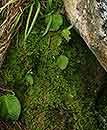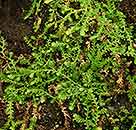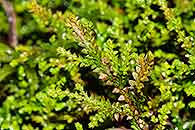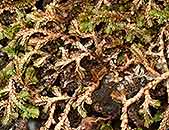Selaginella mittenii Baker
Synonyms |
Selaginella depressa sensu Sim |
|---|---|
Common name |
|
Description |
Plant creeping, moss-like, with stem up to 10–15 cm long and about 0.3 mm in diam., branched; rhizophores along the entire length of the plant, filiform, pale yellow, short, 0.5–1 cm long; branches regularly arranged along the stem, pinnate, diverging 45º with the stem, flattened against the ground. Leaves heteromorphic, bright green, midrib inconspicuous, curl beneath the stem when dry; lateral leaves ovate-elliptic in outline, spreading, base unequally cordate, apex pointed, margin minutely toothed, 1.25-2 × 0.75-1.1 mm; median leaves overlapping, ovate-lanceolate to elliptic in outline, apex pointed, base subtruncate, margin ciliate to toothed, 0.5-1.2 x 0.3-0.4 mm; axillary leaves 1.2–1.3 x 0.5–0.6 mm, lanceolate in outline, apex pointed, base rounded, margin ciliate below and toothed above. Strobili situated on the end of the branches, 4-8 x 1.5-2 mm. Sporophylls homomorphic, in four rows, imbricate, 1.5–1.7 x c. 0.8 mm, broadly ovate-lanceolate in outline, apex tapering, base auriculate, margin ciliate-toothed; 2 kind of spores. |
Notes | Can be distinguished from Selaginella kraussiana which has bigger lateral leaves and a more springy habit (it does not lay appressed to the ground like S. mittenii). Confusion with Selaginella perpusilla is possible, but this is only known from the Lundi river bridge in southern Zimbabwe. The lateral leaves of S. perpusilla do not curl when dry. |
Derivation | mittenii: named after W. Mitten, British bryologist. |
Habitat | In moist evergreen forest or deciduous woodland, along earth-or streambank or in rocky areas, in lee of boulders in grassland, exposed or deeply shaded. |
Distribution worldwide | Africa, India. |
Distribution in Africa |
Angola, Burundi, Dem. Republic of Congo, Kenya, Lesotho, Malawi, Mozambique, Rwanda, South Africa, Sudan and South Sudan, Swaziland, Tanzania , Uganda, Zambia, Zimbabwe. |
Growth form |
Lithophytic, terrestrial. |
Literature |
|




